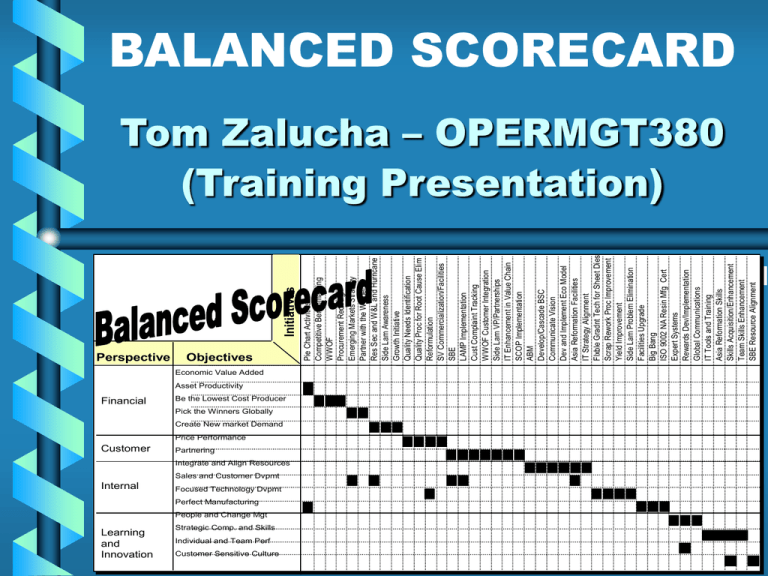
Perspective
Economic Value Added
Financial
Customer
Internal
Learning
and
Innovation
Objectives
Asset Productivity
Be the Lowest Cost Producer
Pick the Winners Globally
Create New market Demand
Price Performance
Partnering
Integrate and Align Resources
Sales and Customer Dvpmt
Focused Technology Dvpmt
Perfect Manufacturing
People and Change Mgt
Strategic Comp. and Skills
Individual and Team Perf
Customer Sensitive Culture
Pie Chart Activities
Competitive Benchmarking
WWOF
Procurement Redesign
Emerging Markets Strategy
Partner with the Winners
Res Sec and W&L and Hurricane
Side Lam Awareness
Growth Initiative
Quality Needs Identification
Quality Proc for Root Cause Elim
Reformulation
SV Commercialization/Facilities
SBE
LAMP Implementation
Cust Complaint Tracking
WWOF Customer Integration
Side Lam VP/Partnerships
IT Enhancement in Value Chain
SCOP Implementation
ABM
Develop/Cascade BSC
Communicate Vision
Dev and Implement Eco Model
Asia Reformation Facilities
IT Strategy Alignment
Flxble Gradnt Tech for Sheet Dies
Scrap Rework Proc Improvement
Yield Improvement
Side Lam Problem Elimination
Facilities Upgrade
Big Bang
ISO 9002 NA Resin Mfg Cert
Expert Systems
Rewards Dev/Implementation
Global Communications
IT Tools and Training
Asia Reformation Skills
Skills Acquisition/Enhancement
Team Skills Enhancement
SBE Resource Alignment
Initiatives
BALANCED SCORECARD
Tom Zalucha – OPERMGT380
(Training Presentation)
BALANCED SCORECARD
What Will Be Covered
•
•
•
•
•
•
Background and Definition
How Can This Tool Be Used
Nuts and Bolts – How It Works
Building A Balanced Scorecard
Examples and Exercises
Summary / Reading List
BALANCED SCORECARD
Background and Definition
• History of Balanced Scorecard
• Balanced Scorecard Defined
Financial Perspective
Customer Perspective
Internal Process Perspective
Employee Growth Perspective
BALANCED SCORECARD
How Can This Tool Be Used
(Exercise)
•
•
•
•
What Is the Vision of the Future
If Vision Succeeds, How Will We Differ
What Are the Critical Success Factors
What Are the Critical Measurements
BALANCED SCORECARD
How Can This Tool Be Used
(Answer)
• Forming vs Executing Strategy
• Balanced Scorecard Approach
BALANCED SCORECARD
Nuts and Bolts – How It Works
(Strategy Focused Principles)
•
•
•
•
•
Translate Strategy
Organization Alignment
Strategy Is Everyone’s Job
Strategy a Continual Process
Executive Leadership
BALANCED SCORECARD
Nuts and Bolts – How It Works
(Strategy Focused Diagram)
The Principles of a Strategy-Focused Organization
TRANSLATE
STRATEGY
•
•
•
•
•
EXECUTIVE
LEADERSHIP
Mission / Vision
Strategy Maps
Balanced Scorecard
Targets
Initiatives
BALANCED
SCORECARD
•
•
•
•
•
CEO Sponsorship
Executive Team Engaged
“New Way of Managing”
Accountable for Strategy
A Performance Culture
•
•
•
•
•
STRATEGY IS A
CONTINUAL
PROCESS
Linked to Budgeting
Linked to Ops. Mgmt.
Management Meetings
Feedback System
Learning Process
ORGANIZATION
ALIGNMENT
•
•
•
•
Corporate Role
Corporate - SBU
SBU - Shared Services
External Partners
STRATEGY IS
EVERYONE’S
JOB
• Strategic Awareness
• Goal Alignment
• Linked Incentives
©2002 Balanced Scorecard Collaborative, Inc and Robert S. Kaplan. All rights reserved.
8
BALANCED SCORECARD
Building A Balanced Scorecard
(Process Overview)
Define
Strategic
Destination
Build the
Strategic
Linkages
Identify Key
Themes
Driving the
Strategy
Strategy
Themes
Objectives
Select
Priority
Initiatives
Determine
Measures and
Targets
Measures
& Targets
Prioritized
Initiatives
Plan for
Implementing
Implementation
Plan
BALANCED SCORECARD
Building A Balanced Scorecard
(Linking Measures to Strategy)
Begin by Linking Measurements to Strategy
Vision Statement
Mission Statement
Definition of Business Unit
What is the Vision of
the Future?
If Vision Succeeds,
How Will We Differ?
To My Shareholders
Financial
Perspective
To My Customers
Customer
Perspective
With My Processes
Internal Process
Perspective
What Are the Critical
Success Factors?
What Are the Critical
Measurements?
THE BALANCED SCORECARD
With My Employees
Employee Learning
Perspective
BALANCED SCORECARD
Building A Balanced Scorecard
(Translating Vision & Strategy)
Translating Vision and Strategy - Four Perspectives
How should we Financial
appear to our Objectives Measures Targets Initiatives
shareholders
and potential
investors?
Customer
How should Objectives Measures Targets Initiatives
we appear
to our
customers?
Vision and Strategy
How will we Employee Growth
sustain our Objectives Measures Targets Initiatives
ability to
change and
improve?
Internal Process
What business Objectives Measures Targets
processes
should/must
we excel at?
Initiatives
BALANCED SCORECARD
Building A Balanced Scorecard
(Aligning Strategy)
Corporate
Division
Using the Balance Scorecard
at each level in a company
helps to align the strategy
throughout the organization.
Location/Dept.
Individual
BALANCED SCORECARD
Building A Balanced Scorecard
(Scorecard Overview)
Vision & Strategy
Financial Perspective
EVA
Strategy
Revenue
Strategy
Productivity
Strategy
Customer Perspective
Operational
Excellence
Customer
Solutions
Product
Leadership
Internal Process Perspective
Innovation
Build the
Brand
Operations &
Logistics
Employee Growth Perspective
Employee
Competencies
Technology
Infrastructure
Business
Culture
Balanced Scorecard
Elements
Business Vision & Strategy
Strategic Themes
Four Business Perspectives
For each Perspective there
are:
Objectives
Measures
Targets
Initiatives
BALANCED SCORECARD
Building A Balanced Scorecard
(Strategy to Operational Terms)
Strategic Theme:
Statement of
what strategy
must achieve
and what’s
critical to its
success.
Objectives
How success
in achieving
the strategy
will be
measured and
tracked.
The level of
performance
or rate of
improvement
needed.
Measurement
Target
Key action
programs
required to
achieve
objectives.
Initiative
BALANCED SCORECARD
Examples and Exercises
(Exercise Steps)
Review business strategy and identify key strategic themes.
List all the strategic themes in your business strategy.
Select one strategic theme and create a strategy map.
Use the selected strategic theme to identify objectives, measures,
targets, and initiatives for one key measure.
Identify the objectives, measures, targets, and initiatives for the
other key measures.
If you have time, select another strategic theme and work through
steps 1-4 again.
BALANCED SCORECARD
Examples and Exercises
(Step1 Review Strategy)
Business is a stocking wholesale distributor of a broad line of building materials
and related services to retail lumber yards and national distribution outlets.
Your goal is to improve the company’s long-term EVA.
Your strategy is to:
Maintain or increase market share in existing trade areas by adding new
products, improving marketing efforts with existing customers, and by focusing
on value-added services
Opportunistically expand into new markets.
Continued emphasis on employee involvement to achieve operational
efficiencies, cost reduction, and effective management of working capital in a
safe operating environment.
BALANCED SCORECARD
Examples and Exercises
(Step2-3 Create Strategy Map)
Steps for creating a strategy map.
Strategic Theme:
Financial Performance
1.
Insert your strategic theme at the top.
2.
For each of the four key measures in the
graphic on the left, identify a specific
objective that will help your business
support the strategic theme and overall
business strategy.
3.
After you have objectives identified for
each key measure, draw arrows to
describe the cause and effect
relationships between the objectives.
Customer Satisfaction
Process Improvement
Employee Satisfaction
BALANCED SCORECARD
Examples and Exercises
(Step2-3 Create Strategy Map)
Strategic Theme:
Operational Efficiency
Profitability
Financial
Fewer
Trucks
Increase
Revenue
Customer
Delivered on
Date Promised
Process
Employee
Steps for creating a strategy map.
1.
Insert your strategic theme at the top.
2.
For each of the four key measures in the
graphic on the left, identify a specific
objective that will help your business
support the strategic theme and overall
business strategy.
3.
After you have objectives identified for
each key measure, draw arrows to
describe the cause and effect
relationships between the objectives.
Reduced Cost
Lower Prices
Efficient Order
Fulfillment
Sale/Operations
Teamwork
BALANCED SCORECARD
Examples and Exercises
(Step4 Identify Terms)
Strategic Theme:
Financial Performance
Statement of
what strategy
must achieve and
what’s critical to
its success.
Objectives
How success in
achieving the
strategy will be
measured and
tracked.
Measurement
The level of
performance
or rate of
improvement
needed.
Key action
programs
required to
achieve
objectives.
Target
Initiative
Customer Satisfaction
Process Improvement
Employee Satisfaction
Blank Strategy Map with Objective,
Measurement, Target, and Initiative
for One Key Measure
BALANCED SCORECARD
Examples and Exercises
(Step4 Identify Terms)
Strategic Theme:
Profitability
Financial Performance
Increase
Revenue
Fewer
Trucks
Customer Satisfaction
Delivered on
Date Promised
Reduced Cost
Lower Prices
Process Improvement
Efficient Order
Fulfillment
Employee Satisfaction
Sale/Operations
Teamwork
Statement of
what strategy
must achieve and
what’s critical to
its success.
Objectives
Efficient Staging
and Loading of
Customer Orders
How success in
achieving the
strategy will be
measured and
tracked.
Measurement
Number of Orders
Pre-staged on
Time for Loading
The level of
performance
or rate of
improvement
needed.
Key action
programs
required to
achieve
objectives.
Target
Initiative
85% by June
2005
Optimize Order
Pre-staging
Process
BALANCED SCORECARD
Examples and Exercises
(Step5 Complete Scorecard)
Strategic Theme:
Financial Performance
Customer Satisfaction
Process Improvement
Employee Satisfaction
Objectives
Measurement
Target
Initiative
BALANCED SCORECARD
Examples and Exercises
(Step5 Complete Scorecard)
Strategic Theme:
Profitability
Financial Performance
Increase
Revenue
Fewer
Trucks
Customer Satisfaction
Delivered on
Date Promised
Reduced Cost
Lower Prices
Process Improvement
Efficient Order
Fulfillment
Employee Satisfaction
Sale/Operations
Teamwork
Objectives
Measurement
Target
Initiative
Profitability
More Customers
Less Investment
Market Value
Truckload Rev.
EVA Charge
Increase Market
Share by 5%
Increase Truck
Revenue by 10%
Orders Delivered
On Time
Lowest Prices
Number of Orders
Delivered on
Date Promised
Exceed
Customer
Expectations 95%
Establish Specific
Delivery Routes
by Customer
Efficient Staging
and Loading of
Customer Orders
Number of Orders
Pre-staged on
Time for Loading
85% by June
2005
Optimize Order
Pre-staging
Process
Improved
Communication
Channels
Percent of Staff
Trained in
Teamwork
90% by June
2005
Promote Delivery
Service
Teamwork &
Communication
Skills Training
BALANCED SCORECARD
Summary and Reading List
(Conclusion)
•
•
•
•
•
•
Focus on Strategy not Tactics
Define Strategy Implementation
Allow Continuous Monitoring
Emphasize Problem Solving & Growth
A Tool Backed up by Leadership
Alignment Across Entire Organization
BALANCED SCORECARD
Summary and Reading List
(Reference Material)
• Kaplan (2001: The Strategy-Focused Organization
• Kaplan (1996): The Balanced Scorecard
• Kaplan (1993): Putting Balanced Scorecard to work
BALANCED SCORECARD
Summary and Reading List
(Definitions)
Strategy: Our plan to add value to the corporation
•Principles: General guidelines for evaluating conduct
•Strategy Map: Diagram of cause-and-effect relationships between strategic objectives
•Themes:
High-level “thrusts” designed to bring focus on key strategic
priorities
•Perspectives: Dimensions against which we examine and translate the strategy
•Objective: Concise statement of what we are going to do. Note: verb-object structure
•Measure:
Articulate what will be monitored to achieve objectives and drive
performance
•Target: Defines amount of improvement required and when ‘success’ will be achieved
•Initiative:
Discrete action programs with beginning and end designed to close
a gap, support an objective, or achieve a specific set of outcomes
•





